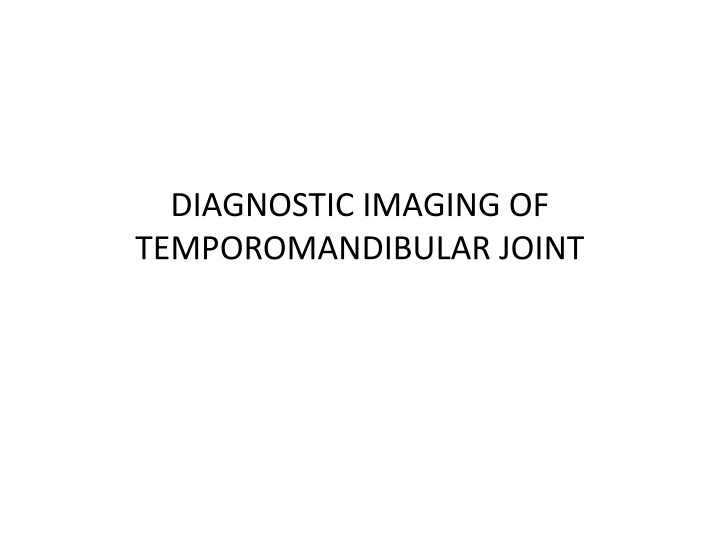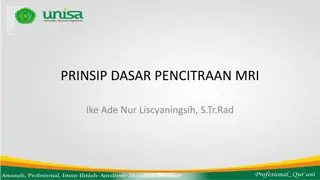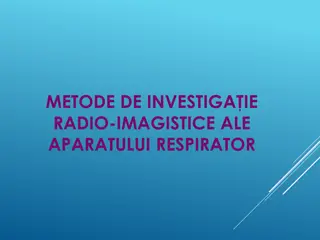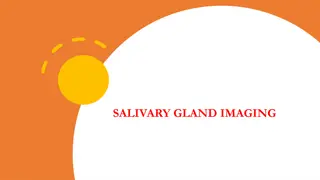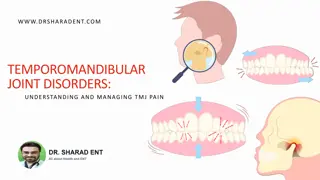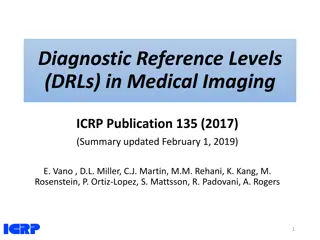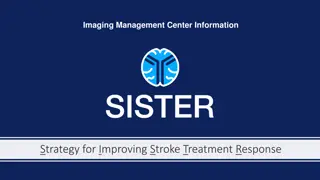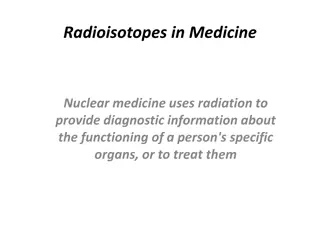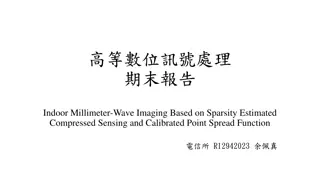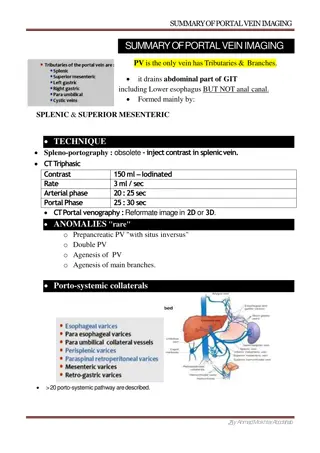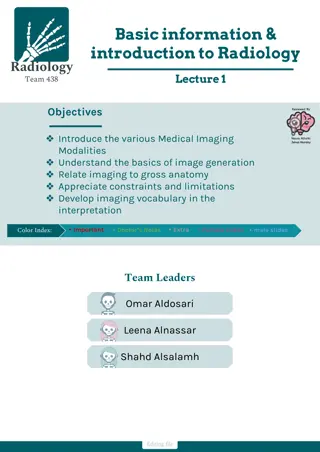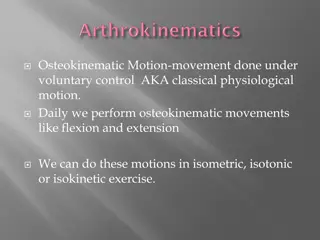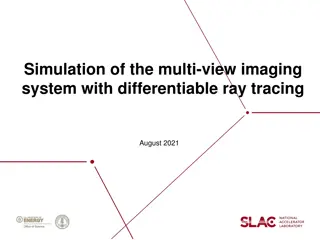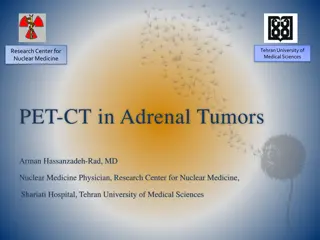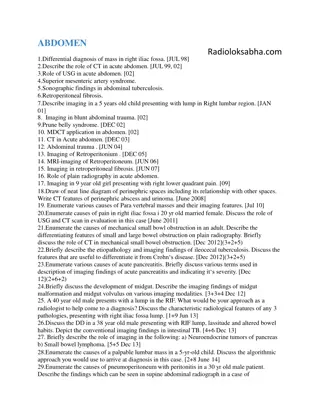DIAGNOSTIC IMAGING OF TEMPOROMANDIBULAR JOINT
This article discusses the diagnostic imaging, clinical features, and anatomy of the temporomandibular joint (TMJ). It covers common symptoms, the structure of the interarticular disk, and the function of the soft tissue components in TMJ movement.
Download Presentation

Please find below an Image/Link to download the presentation.
The content on the website is provided AS IS for your information and personal use only. It may not be sold, licensed, or shared on other websites without obtaining consent from the author.If you encounter any issues during the download, it is possible that the publisher has removed the file from their server.
You are allowed to download the files provided on this website for personal or commercial use, subject to the condition that they are used lawfully. All files are the property of their respective owners.
The content on the website is provided AS IS for your information and personal use only. It may not be sold, licensed, or shared on other websites without obtaining consent from the author.
E N D
Presentation Transcript
DIAGNOSTIC IMAGING OF TEMPOROMANDIBULAR JOINT
Clinical features Pain in the TMJ or ear or both Headache Muscle tenderness joint stiffness Clicking and other joint noises Reduced range of motion Locking and subluxation
Anatomy of interarticular disk It is composed of fibrous connective tissue and is located b/w condylar head and mandibular fossa Disk divides joint cavity into 2 compartments called inferior and superior joint spaces, which are located below and above the disk Disk has a biconcave shape with a thick anterior band, thicker posterior band and a thin middle part It is also thicker medially than laterally Medial and lateral margins of disk blend with the capsule Thin central portion normally serves as an articulating cushion b/w condyle and articular eminence
Anterior band is thought to be attached to the superior head of lat pterygoid muscle and posterior band attaches to posterior retrodiskal tissues Junction b/w posterior band and posterior attachment usually lies within 10 degrees of vertical above condylar head Disk and posterior attachment are called soft tissue component of TMJ
During mandibular opening, condyle translates downward and forward, disk also moves forward and rotates so that its thin central portion remains b/w articulating convexities of condylar head and art eminence Laterally and medially, disk attaches to condylar poles, helping to ensure passive movement of disk with condyle so that condyle and disk translate froward to the summit of art eminence As mandible opens, condyle also rotates against the lower surface of disk in inferior joint space On closing, reverse occurs with disk moving back with condyle into fossa
Posterior attachment Syn: retrodiskal tissues It consists of bilaminar zone of vascularised and innervated loose fibroelastic tissue Superior lamina, rich in elastin, inserts into posterior wall of fossa Superior lamina stretches and allows the disk to move forward with condylar translation Inferior lamina attaches to posterior surface of condyle As condyle moves forward, tissues of posterior attachment expands, primarily as a result of venous distension, as the disk moves forward, tension is produced in the posterior attachment This tension is responsible for smooth recoil of disk posteriorly as mandible closes
TMJ bony relationships Radiographic joint space is used to describe the radiolucent area b/w condyle and temporal component Left and right condylar positions within the fossa can be determined and compared by the dimensions of the r/g joint spcae Condyle is positioned concentrically when anterior and posterior joint space are uniform in width In retruded position, posterior joint space width is less than the anterior In protrusion, posterior joint space is wider than anterior joint space
Condylar movement Opening: Downward and forward translation of condyle occurs, whereby te superior surface of disk slides against the articular eminence Same time, a hinge type, rotatory movement occurs with superior surface of condyle against the inferior surface of disk At maximal opening, condyle moves down and forward to the summit of art eminence or slightly anterior to it Condyle typically is found within a range of 2 to 5mm posterior and 5 to 8mm anterior to the crest of eminence Hypermobility of the joint if condyle translates more than 5mm anterior to eminence
Diagnostic imaging of the TMJ Depends on: 1. Imaging of hard or soft tissues 2. Amount of diagnostic information available from particular imaging 3. Cost of examination 4. Radiation dose
Hard tissue imaging Panoramic projection Transcranial projection Transpharyngeal projection Transorbital projection Submentovertex projection Conventional tomography Computed tomography
Panoramic projection Provides an overall view of teeth and jaws As a screening projection to odontogenic diseases and to disorders that may be source of TMJ symptoms Gross changes such such as asymmetries, extensive erosions, large osteophytes or fractures can be identified
Transcranial projection It provides a saggital view of lateral aspects of condyle and temporal component Pt is positioned in a cephalostat and x ray beam is directed downward from the opposite side, through the cranium and above the petrous ridge of temporal bone, at a 25 degree angle centered through the joint and 20 degree anterior angle may be used Film cassatte is placed on side of concern It includes in closed and maximal open positions
Coz of positive beam angulation, central and medial aspects of joint are projected inferiorly and only lateral joint contours are visible in this projection Ipsilateral petrous ridge is often supermposed over condylar neck and so condylar head, temporal component and joint space is distorted. So horizontal beam angle be individualized to each pt Indications: gross osseous changes on lateral aspect of joint, displaced condylar fractures, and range of motion
Transpharyngeal projection (Pharma) Provides a saggital view of medial pole of condyle Beam is directed superiorly at -5 degrees through the sigmoid notch of opposite side and 7 to 8 degrees from anterior Film cassatte is palced on side being imaged Pt opens the mouth maximally to avoid superimposition of condyle on temporal component Coz of negative angulation, this view depicts medial aspect of condyle Indications: for visualizing erosive changes of condyle rather than subtle changes
Transorbital projection Provides anterior view of the TMJ Pts head is tilted downward 10 degrees so that the canthomeatal line is horizontal Beam is directed from the front of pt through the ipsilateral orbit and TMJ of interest Cassatte is placed behind the pts head, perpendicular to beam Pt opens mouth maximally or protrudes mandible. Thereby placing condyle at summit of eminence
Entire mediolateral dimension of eminence, condylar head and neck is visible Indications: condylar neck fractures, in gross degenerative changes or other anomalies to look for gross changes in morphology of convex surface of condylar head This projection is limited by the ability of condyle to move to the summit of art eminence
Reverse open Townes projection Is used to image condylar neck fractures, particularly if medial displacement has occurred Here the condylar head and neck are visualized in the frontal plane
Submentovertex (Basal) projection Provides a view of skull base and condyles superimposed on condylar necks and mandibular rami It is used to determine the angulations of long axis of condylar head for corrected tomography Useful to evaluate facial asymmetries, condylar dispalcement or rotation of mandible in horizontal plane associated with trauma or orthognathic surgery
Conventional tomography Technique that produces multiple thin image slices, permitting visualization of an anatomic structure essentially free of superimpositions of overlapping structures Coz it provides multiple image slices at right angles through the joint, it is superior to transcranial view It Is exposed in sagittal plane with several image slices in closed postion and usually one image in maximal open position
In corrected sagittal tomography, condylar long axis with respect to midsagittal plane is determined using an SMV Pts head is then rotated to this angle, permitting alignment of image slices perpendicular to condylar long axis This minimizes geometric distortion of joint and allows accurate assessment of condylar position Coronal (frontal) tomographs, pt is in maximal open or protruded position and useful when morphologic abnormalities or erosive changes of condylar head is suspected
Computed tomography Indicated when information about 3 D shape and internal structure of osseous components of joint or if information regarding the surrounding soft tissues is required Image slices are made in both axial and coronal planes Reformat images are produced in sagittal planes and 3D Indications: to assess osseous deformities of jaws or surrounding structures
Indications Presence and extent of ankylosis and neoplasms Extent of bone involvement in some arthritis Imaging complex fractures Evaluating complications from use of polytetrafluoroethylene or silicon sheet implants such as erosions into middle cranial fossa and heterotopic bone growth
Soft tissue imaging Arthrography Magnetic resonance imaging
Arthrography Is a technique in which an indirect image of disk is obtained by injecting a r opaque contrast agent into one or both joint spaces under fluoroscopic guidance Perforation is detected by flow of contrast agent into superior joint space from lower space Adhesions ared etected by the manner in which contrast agent fills the joint space After both spaces are filled, disk function is studied using fluoroscopy during opening and closing movements
Is indicated when information about disk position, function, morphology and integrity of diskal attachments is required for treatment Drawbacks: invasive nature and postoperative discomfort
Magnetic resonance imaging MRI uses a magnetic field and radiofrequency pulses rather than ionizing radiation to produce multiple digital image slices it allows construction of images in sagittal and coronal planes without repositioning the pt Images are acquired in open and closed mandibular positions using surface coils to improve image resolution Examination usually are performed using T1 weighted, proton weighted or T2 weighted pulse sequences
T1 weighted or proton weighted images best demonstrate osseous and diskal tissues T2 weighted demonstrate inflammation and joint effusion medial disk displacements are best detected using MRI Contraindications: pregnancy Pts with pacemakers Intracranial vascular clips or metal particles in vital structures
Developmental abnormalities Condylar hyperplasia Condylar hypoplasia Juvenile arthrosis Coronoid hyperplasia Bifid condyle
Condylar hyperplasia Is a developmental abnormality that results in enlargement and occasionally deformity of condylar head This has secondary effect on mandibular fossa as it remodels to accommodate the abnormal condyle Etiology may be overactive cartilage or persistent cartilaginous rests, increasing the thickness of entire cartilaginous and precartiliginous layers Condition is unilateral and may be accompanied by varying degrees of hyperplasia of ipsilateral mandible
Clinical features Is more common in males Before age of 20 yrs Self limiting condition and tends to arrest with termination of skeletal growth May progress slowly or rapidly Mandibular asymmetry that varies in severity, depending on degree of condylar enlargement Chin may be deviated to unaffected side or may remian unchanged Increase in vertical dimension of ramus, mandibular body or alveolar process of affected side Posterior open bite on affected side, limited/ deviated opening
Radiographic features Condyle may appear relatively normal but enlarged or altered in shape May be more r opaque coz of additional bone present It is seen as elongation of condylar head and neck with a compensating forward bend, forming an inverted L Condylar neck may be elongated and thickened and may bend laterally Cortical thickness and trabecular pattern of enlarged condyle are normal Glenoid fossa may be enlarged at the expense of posterior slope of eminence
Ramus and mandibular body on affected side also may be enlarged, resulting in a characteristic depression of inferior border at midline Affected ramus may have increased vertical depth amd may be thicker in AP dimension
Treatment Orthodontics and orthognathic surgery after condylar growth is complete
Condylar hypoplasia Is a failure of the condyle to attain normal size coz of congenital and developmental abnormalities or acquired diseases that affect condylar growth Condyle is small but with normal morphology Early injury or injury to art cartilage by birth trauma or intraarticular inflammatory lesions
Clinical features Often is associated with underdeveloped ramus and mandibular body Congenital abnormalities may be uni/bilateral and are manifested as a gen condition Also may be associated with congenital defects of ear and zygomatic arch Pts have mandibular asymmetry and may have symptoms of TMJ dysfunction Chin is deviated to affected side Mandible deviates to affected side during opening
Radiographic features Condyle is normal in shape and structure but diminished in size Mandibular fossa is proportionally small Condylar neck and coronoid process usually are very slender and in some cases are shortened or elongated Posterior border of ramus and condylar neck may have a dorsal inclination Ramus and mandibular body on affected side may also be small, resulting in mandibular asymmetry and occasional dental crowding Antegonial notch is deepened
Juvenile arthrosis Syn: Boering s arthrosis Arthrosis deformans juvenilis Manifests as hypoplasia and characteristic morphologic abnormalities Affected condyle was normal at one time and became abnormal during growth May be uni/bilateral
Clinical features Affects children and adolescents during period of mandibular growth It is more common in females Pt may have mandibular mandibular asymmetry, signs and symptoms of TMJ dysfunction or both
Radiographic features Condylar head develops a characteristic toadstool appearance, with marked flattening and apparent elongation of the articulating condylar surface and dorsal inclination of condyle and neck Condylar neck is shortened or even absent in some cases Articulating surface of temporal component often is flattened Progressive shortening of ramus occurs on affected side, and antegonial notch may be deepened, indicating mandibular hypoplasia In longstanding cases, superimposed degenerative changes may be present
Treatment Orthognathic surgery and orthodontic therapy may be required to correct mandibular asymmetry
Coronoid hyperplasia May be acqiured or developmental, resulting in elongation of coronoid process In developmental variant, it is usually bilatral Acquired types may be unilateral or bilateral and are usually are a response to restricted condylar movement caused by abnormalities such as ankylosis
Clinical features Bilateral developmental coronoid hyperplasia is more common in males Often commences at the onset of puberty Pt c/o progressive inability to open the mouth and may have an apparent closed lock Condition is painless
Radiographic features Coronoid processes are elongated and the tips extend atleast 1cm above the inferior rim of zy arch This results in impingement on medial surface of zy arch during opening, restricting condylar translation Coronoid processes may have a large but normal shape or may curve anteriorly and may appear very r opaque Posterior surface of zy process of maxilla may be remodelled to accommodate enlarged coronoid process
